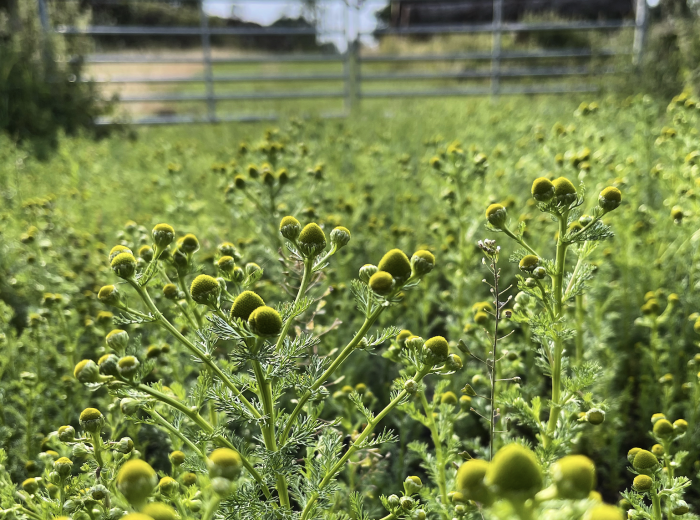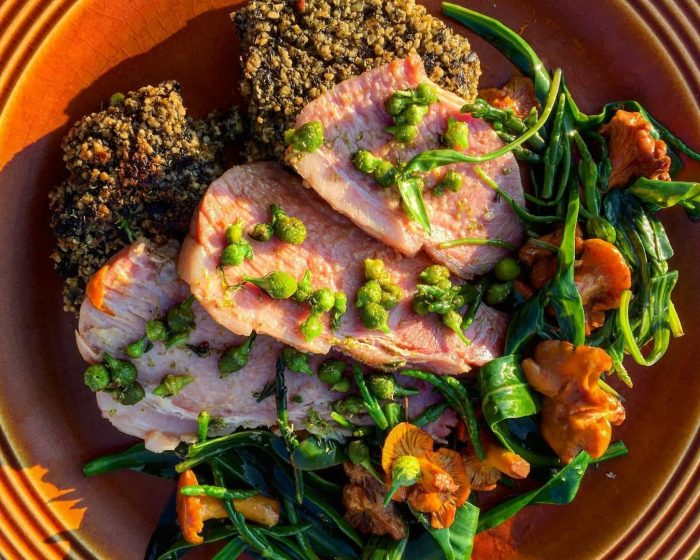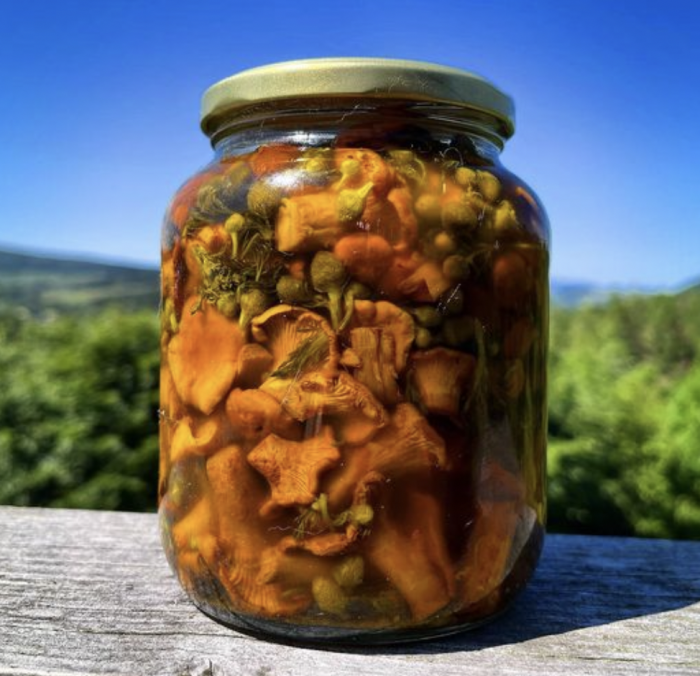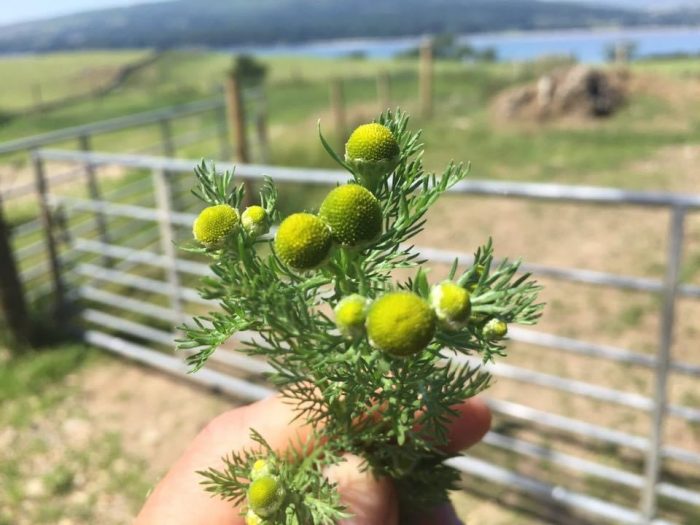Pineapple Weed – Identification, Edibility, Distribution, Ecology, Recipes
Matricaria discoidea (also, occasionally syn. Matricaria matricarioides)
AKA: Pineapple mayweed, disc mayweed, rayless mayweed, wild chamomile, pineapple chamomile, pavement weed

Pineapple weed, Matricaria discoidea. It thrives in disturbed, compacted ground and is most typically found at farm gates.
Identification – 4/5
Unmistakeable once you crush and smell a flower, to reveal its distinctive fruity pineapple – mango – apple scent, but could easily be mixed up pre-flowering (especially with other types of chamomile) as most of its distinctive tropical aroma is in its flowers.
The foliage smells less fruity, more like chamomile. Growing to between 5 and 35cm tall from a dense basal rosette, later with stems growing alternately from the central flowering stem. Leaves are so finely divided, they have a somewhat feathery appearance.
The flowers are yellow with a hint of green, resembling the shape of an acorn, with the compound flower ‘cupped’ in rounded sepals. The flowers are best thought of as the middle our of a daisy, lacking the white ray florets. Close inspection of these compound flowers with a hand lens reveals that they are in fact dozens of tiny flowers, and when I show people this on my guided walks they tend to have a “wow” moment, as they recalibrate their idea of what a flower really is!
Possible (harmless) confusion may occur pre-flowering with other members of the asteraceae family, especially other chamomiles, daisies and perhaps yarrow, but smell is still helpful when only the foliage is apparent.
For those with a poor sense of smell and careless observation skills, the somewhat toxic groundsel (Senecio vulgaris) may – at a stretch – be a possible lookalike prior to its flower buds opening, and shares similar habitats.

Pineapple weed flowers and leaves
Edibility – 5/5 – The whole plant is edible, used mostly for infusing its fruity-chamomile aromatics into teas, syrups, cordials, vinegar, wild flower champagne, mead etc, but the main prize is in the flowers, which contain most of the fruity flavour and some sweetness. The foliage has a pleasing slightly fruity chamomile flavour with a little bitterness, but stems can be tough and chewy. Check out my sweet and savoury recipe suggestions below. While pineapple weed is far from being a common allergen, it is reported to cause allergic reactions in some people. I rather suspect this is the sort of covering-all-bases warning that gets over-amplified through the internet and makes folk more nervous than they need to be about helpful plants, so just use common sense… try a little first time round, and avoid if you are allergic to chamomile. Pineapple weed is noted for its calming effect and is used as a mild sedative by herbalists – great for a bedtime cuppa to soothe you off to la-la land.
Sustainable Harvesting Notes – You’d have to make a concerted effort to over-harvest such a prolific and fast-growing plant. Nevertheless, the usual forager’s common sense-itivities should apply – spread your picking around and don’t wipe out whole areas. When harvesting for the fruity aromatics, I grasp clumps of the flower heads and snip them off, with he aim of 70%+ of what I harvest being the flowers. More pernickety foragers may harvest only the flowers, but this is fiddly work. Lower down there is more tough stem and less fruity flavour. If I’m picking it to use as tea, I tolerate a lot more of the green parts.
UK Distribution – 4/5 – Extremely common in its habitat throughout the UK, where it arrived from North America in the late 1800’s. It is native to North-East Asia.
Habitat – Strong preference for disturbed then compacted ground – most typically (farm) gates and the edges of untarred car parks, footpaths and desire lines through fields. Also in vegetable plots.
UK Season – May – October, though the main flowering period is June – early September
Ecological Notes – The flowers attract , bees, butterflies and tiny syphrid flies. Each dome of flowers can produce thousands of sticky little seeds, which attach themselves to passing animals – including humans – and even tyres. Pineapple weed has very much benefited from human activity, as noted by Richard Maybe in his excellent book “Weeds”: “The spread of the fruitily perfumed pineapple weed, which arrived in Britain from Oregon in 1871, exactly tracked the adoption of the treaded motor tyre, to which its ribbed seeds clung as if they were the soles of small climbing boots.”

Pineapple weed – a great example of a delicious “weed” that hides in plain site in both urban and rural settings
Nothing makes the notion of “weeds” look more redundant than this delightful and delicious little plant.
Pineapple weed is a summer star of the wild food year, bringing fruity flavours just ahead of the the arrival of fruits like wild strawberry (with which they pair wonderfully) and raspberries. Crushing and smelling the leaves never fails to bring “ooohs” of delight, whether folk are discovering it for the first time, or recollecting playing with it as a child. Its a brilliant plant to teach to children as they love the fruity, almost bubble gum like smell and sharing it with friends will make them stars of the playground.
Pineapple weed is very much a “gateway plant”, enticing the playful with its surprising smell, then spurring them on to discover other delicious “weeds”, while, by happy coincidence, being most often found in gateways!
Its versatile in the kitchen, working in both sweet and savoury settings.
Pineapple Weed Savoury Recipes
Although pineapple weed flowers are not juicy like a fruit, the flowers still add a pleasingly soft fruity succulence to salads.
Scattered among roasting carrots the flowers add an excellent complimentary sweet-herbal note.
They make a nice variation on the traditional (but rather peculiar) tradition of pairing pineapple with gammon. I tossed the flowers in the hot fat a few times and scattered them on the meat and served with other wild food stars of the summer – chanterelles and marsh samphire. I have to say, it was better than using actual pineapple! If that floats your boat, try using on a ham and pineapple (weed!) pizza…

Pineapple weed with gammon, chanterelles, salt marsh greens and laverbread
Chanterelles pickled with pineapple weed recipe
In damp west Scotland chanterelle season begins in June, just as pineapple weed starts to flower. Chanterelles are often described as having a scent of apricots, and while my olfactory senses don’t quite get apricot, I do find them fruity. So it wasn’t such a bizarre leap of imagination to add pineapple weed flowers to my pickling mix. Their fruity and chamomile flavours worked really well with the young chanterelles.
Partially dry clean, firm chanterelles for about 1 hour in a dehydrator on a low setting (or leave in a warm dry spot overnight). The aim is not to dehydrate them, but to ensure they aren’t really wet. This allows them to absorb more of the pickling liquor. You could use fully dried chanterelles for this recipe if that is all you have, but I find dried chanterelles have lost most of their charm.
Simmer the chanterelles for 10 minutes with a few handfuls of pineapple weed flowers in a 3-2-1 pickle solution comprising 3 parts water, 2 parts apple cider vinegar (possibly pre-infused with pineapple weed, as detailed below), 1 part sugar, and a generous pinch of salt. Add any other spices you fancy at this stage.
Transfer the hot pickle into very clean jars, ensuring the solids are immersed in the vinegar solution – I use small round plastic tubs with holes punched in the bottom that fit snugly just below the jar lid.
Screw on the lids and leave to cool before storing in the fridge.
They’ll keep for months in the fridge unopened, but use within a couple of weeks once opened. They are great with cured meats.

Chanterelles hot-pickled with pineapple weed
Pineapple Weed Vinegar Recipe
On the subject of pickling, pineapple weed infused apple cider vinegar is one of my go-to pickle bases. To make it just half fill a jar with the flower tops, top it up with vinegar then leave for a couple of weeks. Its a great base for salad dressings, or pickling summer succulents such as marsh samphire, rock samphire, sea aster, sea plantain, or the pickled chanterelle recipe above.
Pineapple Weed Sweet Recipes
If you sweeten your pineapple weed vinegar with sugar to make a shrub (or with honey to make an oxymel) it becomes a magical ingredient for tempering cocktails, or diluting with cold water to make a refreshing long drink in summer, or with hot water on cold days.

Pineapple weed cocktail made with gin, elderflower liqueur, pineapple weed oxymel and sweet woodruff wine
Pineapple Weed Syrup and Cordial Recipe
Pineapple weed readily infuses into syrups which opens the door to jelly and all manner of other sweet treats such as turkish delight.
To make pineapple weed syrup, just mix a jug of flowers with the same volume of water and the same volume of sugar, heat gently (but don’t boil), stirring until all the sugar has dissolved, allow to cool, then heat gently again, before pouring into jars with the flowers still in. Leave to cool then keep in the fridge for a week, before straining out the flowers. Store in the fridge or freeze, as it will want to ferment.
You can of course deliberately ferment pineapple weed to make wine or champagne – recipe here.
With the addition of some citric acid (to taste, as powder or as lemon juice), pineapple weed syrup becomes an excellent cordial that not only has the aroma of pineapple, but also the sweet acidity.
Pineapple Weed and Wild Strawberries
The flowers of pineapple weed pair wonderfully with wild strawberries, which ripen at the same time and are are about the same size. Try mixing the two in jams and puddings.
Pineapple Weed Marmalade Recipe
Pineapple weed captures people’s imagination like few other wild foods and a post about it on my Facebook Page brought a huge response, including this intriguing recipe from Hannah Michelle:
“Follow a standard marmalade recipe: collect enough flower heads, to match pound for pound with sugar, add all flower heads with sugar and water. Add one lemon chopped up small, rind and all. Bring to the boil. Just before it reaches setting point, add in wild oregano and seal in sterile jars.”

Pineapple weed – as so often is the case, by a gate!
Pineapple Weed Tea
For all its many uses, perhaps the simplest and most delightful way to use pineapple weed is as calming tea – perfect at bedtime for sending you off to sweet, fruity dreams! Use fresh sprigs for the best flavour. They still make a tasty tea once dried, but it will be rather less fruity. Freezing helps keep more of the fruity flavour.
Related Posts:
- More summer wild foods
- Blog: Foraging Starts at Home
- Rosebay Willowherb – Edibility, Identification, Distribution, Ecology, Recipes